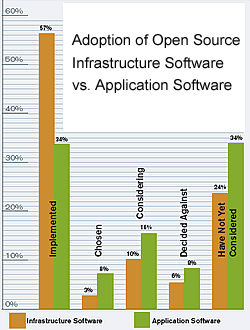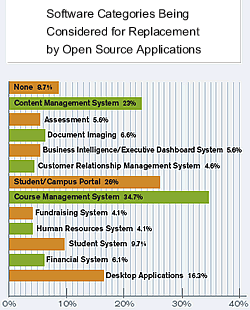In Gear for Open Source?
Higher education hasn’t yet made a big shift toward open source applications.

Open source infrastructure software, such as
operating
systems, authentication systems, and
web servers—software
likely to be used directly
by the IT department—shows 57
percent adoption
in the higher ed institutions represented in
A-HEC’s study, versus the 34 percent adoption of
open
source software applications for more general
use, such as
course management systems,
portals, and a range of desktop
applications.
Source: A-HEC Higher Education Open Source Study 2006.
IN CLASSIC MODELS of open source adoption—
such as Linux and Apache
—a grassroots, lower-end market rallied around a variety of
well-known and widely shared causes among software developers:
innovation, customization, cost control, and security.
None of these values are foreign to higher education. Still,
though IT leaders in higher ed have expressed a lot of interest,
it looks like open source adoption in higher education
application areas may still be in somewhat of a low gear.
The first study in a series from the Alliance for Higher Education Competitiveness and IMS, Best Practices in Open Source in
Higher Education Study: The State of Open Source Software
(2006), by IMS CEO Rob Abel, attempts to characterize
attitudes toward open source in higher ed and provide
insight into adoption by surveying approximately 200
CIOs (or IT leaders in similar positions) across all Carnegie
classes. A brief look at data selected from the more than
40 charts in this detailed study may offer a little perspective
on the cautious adoption of open source applications within
higher ed.
Infrastructure vs. Applications
A-HEC’s study reported that open source infrastructure
software (implemented and used mostly by the IT department) was adopted at some level in more than half of
the responding institutions. In contrast, open source
application software (used more generally throughout
the institution) was adopted at only about one-third of
the institutions surveyed, and only about 25 percent of
institutions implemented any of the short list of leading
open source applications identified by the A-HEC
researchers.

A-HEC’s study participants were asked to identify the
general categories of application software being considered
for replacement with open source software at their
institutions.
Notably, course management systems
reflected the highest
percentages.
Source: A-HEC Higher Education Open Source Study 2006.
How much of the gap between open source infrastructure
software and application software adoption
should be attributed to the longer-standing acceptance
of open source in the broader IT marketplace? How
much reflects either lagging support of application
users or a still immature market? Whatever the answers
may be, it’s clear that adoption of open source applications
in higher education has not yet reached its stride.
Replace or Rely?
In terms of the application software market in higher
education, it’s tempting to ask: In which software categories
might we see existing software actually replaced
by open source? Which proprietary vendors would be
replaced? A-HEC study participants responded to
both questions in terms of what was being considered
at their own institutions. But while the numbers are
useful for spotting trends, researchers caution against
direct comparisons, especially in the context of the
data on vendors: The higher percentages for “replacement”
may, at least in part, be a reflection of a larger
market share.
The higher ed market remains heavily reliant on proprietary
vendor solutions for software applications,
especially course management systems. Recent attention
given to Blackboard’s patent action against a smaller competitor illustrates
the intensity of this vendor presence within the higher
education market for software applications. Love-hate
relationships between higher ed clients and these vendors
elicit a gamut of responses, from “If it ain’t broke,
don’t fix it,” to joining consortia and foundations to
develop open source applications that would dethrone
the vendor-monarchs.

An estimated 25 percent of US higher education institutions
have
implemented one or more of the
10 leading open source
software
applications identified by the A-HEC study. Seven of
the
applications
(shown in gray) were implemented by more than
1 percent of institutions.
Source: Derived from the chart “Estimated
Market Adoption of
Select Open Source
Application Software,”
A-HEC Higher Education OpenSource Study 2006.
Ideally, the market would support both open source
and proprietary or open source compatible vendor
applications. Among the conclusions of the A-HEC
study was a pointer to the need for “pervasive adoption
of learning application standards that enable crossindustry
return on investment.” But it’s not a simple picture.
Also noted in the conclusions: “The question is,
can the diverse cultures of commercial companies,
open source developers, and higher education institutions
work together effectively to create an environment
where commercial and open source products are
compatible?”
In contrast to the mainstream open source movement,
we’re just out of the gate for open source adoption
of higher ed applications. And the A-HEC study
captures a point in time. It d'esn’t really portray the passion
of the open source community in this market; the
education “grassroots” counterparts of early Linux and
Apache developers. While the study d'es offer some
positive predictions about increasing adoption in the
next three years, it can’t forecast the long-term effects
community efforts may have. Are they moving into high
gear? It’s conceivable that open source adoption of
higher ed applications will pick up speed, and soon—to
the point where research studies like A-HEC’s will have
a hard time keeping up.